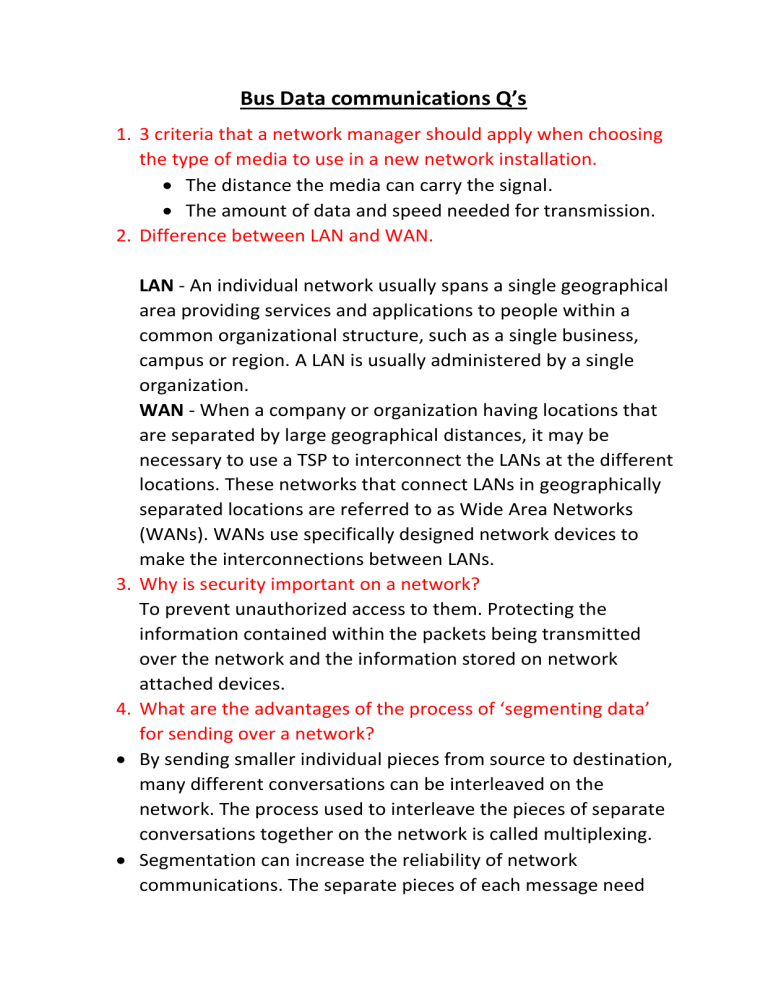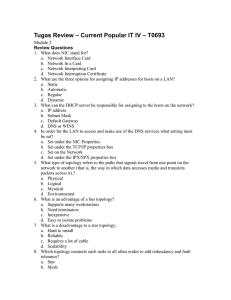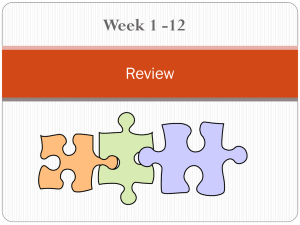Bus Data communications
advertisement

Bus Data communications Q’s 1. 3 criteria that a network manager should apply when choosing the type of media to use in a new network installation. The distance the media can carry the signal. The amount of data and speed needed for transmission. 2. Difference between LAN and WAN. 3. 4. LAN - An individual network usually spans a single geographical area providing services and applications to people within a common organizational structure, such as a single business, campus or region. A LAN is usually administered by a single organization. WAN - When a company or organization having locations that are separated by large geographical distances, it may be necessary to use a TSP to interconnect the LANs at the different locations. These networks that connect LANs in geographically separated locations are referred to as Wide Area Networks (WANs). WANs use specifically designed network devices to make the interconnections between LANs. Why is security important on a network? To prevent unauthorized access to them. Protecting the information contained within the packets being transmitted over the network and the information stored on network attached devices. What are the advantages of the process of ‘segmenting data’ for sending over a network? By sending smaller individual pieces from source to destination, many different conversations can be interleaved on the network. The process used to interleave the pieces of separate conversations together on the network is called multiplexing. Segmentation can increase the reliability of network communications. The separate pieces of each message need not travel the same pathway across the network from source to destination. If part of the message fails to make it to the destination, only the missing parts need to be retransmitted. 5. What is meant buy ‘encapsulation’? At which layer of the OSI model does it occur. Data encapsulation refers to sending data where the data is augmented with successive layers of control information before transmission across a network. 6. List the layers of the OSI reference model, stating the function of each layer. Application - Provides a set of interfaces for applications to access network services • Presentation - Handles data formatting for network communications • Session - Ensures ongoing communication across a network • Transport - Responsible for creating and maintaining endto-end connection. Network - Responsible for network traffic control • Data-link - Provides control of the physical layer and Data detects and corrects errors • Physical - Transforms bits into electromagnetic signals 7. What are the differences between serial and parallel communications? Serial communication is the process of sending data one bit at a time sequentially over a communication channel. Parallel communication can transmit multiple binary digits simultaneously. The key difference between a parallel and serial communication channel is the number of electrical conductors used to convey bits, a parallel channel has more than one conductor. 8. Explain ‘simplex’, half-duplex’ and ‘full-duplex’. Simplex - Data travels in one direction only: unidirectional. Simple communications protocols Used in broadcast networks e.g. CCTV Half-duplex - Data transfer is in both directions: bidirectional. Communication is not simultaneous, therefore each end on the link must wait for their turn to transmit e.g. taxi Full-duplex - Data transfer is bidirectional and simultaneous. Most modern systems are full duplex as there is a significant speed advantage. 9. How does data compression work? Data compression is the process of using less bits to represent the object. Two categories of compression: lossy and lossless • Lossy compression - removes information from the original data that is deemed unnecessary and is most commonly used on multimedia data • Lossless compression - uses statistics to reduce the amount of data needed to represent the information and is typically used on more critical data. 10. If the bandwidth of a network line 100Mb/s would you expect the throughput to more or less? Why? ??? 11. How do we measure delay on a network? End-to-end delay measures the delay from the source to the receiver, in terms of the length of time it takes a packet to be transmitted from the sender across the network to the receiver. A related metric is the round-trip time, RTT, which is the length of time it takes a packet to be transmitted by the sender to the receiver and acknowledgement of receipt received back by the sender. 12. Briefly outline the different types of noise found on networking media. Thermal: happens regardless of whether there is signal or not and is present in every electronic system that is above absolute zero (0 kelvin), TV static is partially due to thermal noise. Crosstalk: this is where transmission in one circuit or channel causes undesirable effects in another circuit or channel. Impulse: this is also called popcorn noise, it involves sudden jumps in voltages on a network and can cause modems to become desynchronised. It is typically caused by faulty electrical equipment close to the network cabling or faulty cabling on the network. 13. Outline the construction of unshielded twisted pair (UTP) cable. 14. Why is optical fibre cable used in long distance communications in preference to copper cable? In fibre optic transmission the light (optical signal) that is generated travels down the fibre cable as it cannot escape and ricochets off the walls of the fibre cable all the way to its destination. Optical fibre cable has a high distance of about 1-100,000 metres compared to coppers short distance of around 1-100 metres. Fibre cable is immune to EMI, RFI and Electrical hazards. 15. What is the purpose of the operating system on a router? Where is it stored? Operating Systems manage the software and hardware resources of a computing device. PC operating systems (Windows 8, Linux and OS X) perform technical functions that enable: Use of a mouse. View output. Enter and store user created content. The Operating system is stored on the hard disk and when the computer is powered on it loads into RAM. 16. Give 3 examples of intermediary devices on a network, and briefly state the function of each. Switch - Layer 2, full duplex, uses MAC address lookup to retransmit on correct port, sends data frames across network. Router - Layer 3, sends data packets between networks, core routers backbone of internet. (Typically, the default gateway of the network.) Hubs - Layer 1, half duplex, broadcasts across all ports (no MAC address information), less reliable, worse bandwidth than a switch. 17. What configuration files are maintained on a switch? ??? 18. What is the purpose of the console port on a router? Allows configuration commands to be entered via terminal emulation for setting up switch/router. • When performing an initial configuration. • When networking services fail, and remote access is not possible. 19. What passwords can be configured on a router? Console (User Verification). Privileged mode (secret for encrypted). Vty for remote access. 20. What network information does an end device need to be able to communicate on the network to which it is connected? Each end device on a network must be configured with an IP address and a subnet mask is also necessary. 21. What are the differences between a normal LAN switch and a Multi-Layer switch? Normal LAN switch - Layer 2, full duplex, uses MAC address lookup to retransmit on correct port, sends data frames across network. Multilayer Switch - Layer 3, essentially a router that can switch, more expensive and complicated to configure 22. In networking what is the differences between a logical topology and a physical topology? Physical topology - identifies the physical placement of the various components of a network, including device location and cable installation. Logical topology - illustrates how data flows within a network, regardless of its physical design. 23. Why is a physical star topology preferred to a physical bus topology? Bus topology has a single point of failure so is bad for a large office network. Star topology is more secure than bus network and is easier to detect faults on the network. 24. Briefly outline ethernet. One of the most widely used LAN technologies. Operates in the data link layer and the physical layer Family of networking technologies that are defined in the IEEE 802.2 and 802.3 standards 25. What are the responsibilities of the MAC sublayer? The MAC sublayer is responsible for Data encapsulation and Media access control. 26. What is meant by the term ‘media access control’? Responsible for the placement of frames on the media and the removal of frames from the media.




